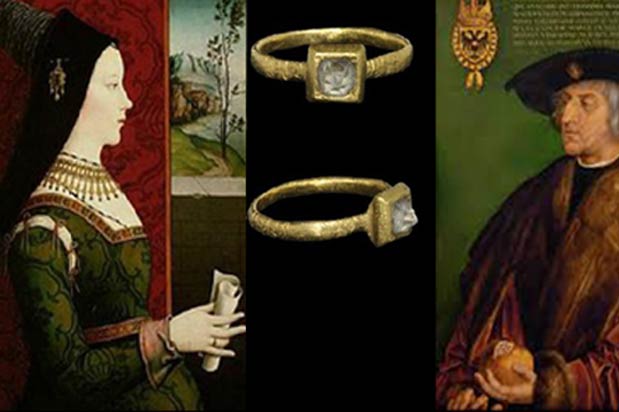The Fascinating History & Symbolism of Engagement Rings
I have been in the fine diamond and jewelry business for over 30 years, and in the research of information for this blog article, I learned of exciting traditions, symbolism and materials used in the declaration and commitment of love and betrothal going back thousands of years. It is very heart-warming to know the tradition continues to grow and expand as I live it every day with each couple I work with who has their own unique way of choosing and designing the symbol of their love. There are endless choices.
The history of the diamond engagement ring is a fascinating journey of love, tradition, symbolism, and evolution that spans centuries, cultures, and civilizations. From ancient rituals and medieval customs to modern trends and contemporary values, the diamond engagement ring continues to symbolize love, commitment, and devotion in diverse and meaningful ways. As couples continue to celebrate their love stories and embark on new beginnings, the diamond engagement ring remains a timeless and cherished symbol of everlasting love, unity, and hope for generations to come.
Ancient Beginnings
The tradition of using a ring as a symbol of engagement dates back to ancient times. Ancient Egyptians are credited with the custom of exchanging rings made from materials like leather or braided hemp as a symbol of eternity. The Romans continued the tradition of engagement rings, but they shifted from simple bands to more ornate designs. Rings often featured intricate carvings or symbols.
Ancient Civilizations
- Egyptian Influence: Ancient Egyptians exchanged rings made from materials like reeds, papyrus, leather, or bone, symbolizing eternal love, unity, and commitment in marital relationships. Rings often featured intricate engravings, hieroglyphics, or symbols representing love, fidelity, and divine blessings, enhancing their significance and value in ancient Egyptian culture.
- Roman Tradition: Ancient Romans introduced the tradition of engagement rings, often made from iron, featuring intricate designs, engravings, or gemstones, symbolizing ownership, fidelity, and mutual respect in marital relationships. Roman engagement ring traditions influenced European customs, practices, and symbolism associated with marriage and family dynamics.
Medieval Europe
- Fede Rings, Symbol of Love and Fidelity: Medieval Europeans exchanged “fede” (faith rings) or promise rings, featuring motifs like clasped hands, hearts, or inscriptions, symbolizing love, fidelity, and commitment in romantic relationships.
- Cultural Heritage: Medieval engagement ring traditions reflected social norms, religious beliefs, and cultural values associated with courtship, marriage, and family dynamics in European societies.
- Posy Rings: Inscribed with romantic poems or messages, posy rings gained popularity as sentimental tokens exchanged between lovers during the Renaissance era.
Renaissance and Enlightenment
Diamond Discoveries
- Diamonds in India: The discovery of diamond mines in India introduced diamonds to European markets, igniting fascination, demand, and desire for these rare and precious gemstones.
- Royal Influence: European royalty, including Queen Elizabeth I, adorned themselves with elaborate diamond jewelry, setting trends and shaping perceptions of diamonds as symbols of wealth, status, and power.
Georgian and Victorian Eras
- Romantic Era: The Georgian and Victorian eras celebrated sentimentality, romance, and love, influencing the design, craftsmanship, and symbolism of engagement rings adorned with intricate details, motifs, and gemstones, including diamonds.
Modern Era
First Diamond Engagement Ring:
While precious stones were occasionally used in engagement rings, it wasn’t until 1477 that the first recorded diamond engagement ring was given. Archduke Maximilian of Austria gave a diamond ring to Mary of Burgundy, marking the beginning of the association between diamonds and engagements. In the 19th century, diamonds gained popularity as engagement ring stones, particularly after the discovery of diamond mines in South Africa. However, diamonds were not as widespread as they are today.
De Beers Marketing Campaigns
- Diamonds are Forever: The 20th century saw a significant transformation in the diamond engagement ring tradition, largely due to a brilliant marketing campaign by the De Beers company. In 1947, they launched the famous slogan “A Diamond is Forever,” promoting the idea that diamonds symbolize eternal love and commitment.
- Cultural Shifts: Post-World War II, there was a surge in prosperity, and the idea of buying a diamond engagement ring became more widespread. The diamond ring became a status symbol and a measure of one’s commitment.
- Popularization in Hollywood: The glamour of Hollywood in the mid-20th century further popularized the concept of diamond engagement rings. Celebrities flaunting their stunning diamond rings contributed to the cultural expectation of a diamond as the ideal engagement gemstone.
- Mass Production: Advancements in mining, cutting, and manufacturing techniques facilitated mass production, accessibility, and affordability of diamond engagement rings, making them more widely available to couples worldwide.
Contemporary Trends
- Continued Symbolism:Today, the diamond engagement ring is deeply ingrained in Western culture and beyond. It symbolizes love, commitment, and the enduring nature of a relationship. The four Cs—cut, carat, color, and clarity—have become key factors in choosing the perfect diamond.
- Personalization and Customization: Modern couples embrace personalized and customized engagement ring designs, settings, and styles which reflect their unique personalities, preferences, and love stories.
- Ethical Sourcing and Sustainability: Increasing awareness and demand for ethical sourcing, sustainability, and responsible practices in the diamond industry drive innovation, transparency, and accountability among jewelers, brands, and consumers.
- Emergence of Alternative Gemstones: In recent years, there has been a growing trend toward unique designs and alternative gemstones, like Lab Grown Diamonds, Moissanite, Morganite, Aquamarine, Tanzanite, Tourmaline, and Opal for engagement rings. Couples are exploring options beyond diamonds, seeking more personalized and meaningful choices.
Engagement Ring Traditions
Engagement ring traditions span across cultures, civilizations, and historical periods, each with unique customs, rituals, symbolic meanings, and cultural significance.
Asian Cultures
- Symbolic Meanings: Various Asian cultures, including Chinese, Indian, and Japanese, have unique engagement ring traditions, customs, and symbolic meanings associated with materials like jade, gold, pearls, or gemstones representing prosperity, luck, purity, and longevity.
- Cultural Significance: Engagement ring traditions in Asian cultures reflect cultural heritage, religious beliefs, social values, and family traditions that shape marital relationships, ceremonies, and celebrations.
Middle Eastern Cultures
- Cultural Customs: Middle Eastern cultures, including Arab, Persian, and Turkish societies, have distinct engagement ring traditions, customs, and rituals, such as exchanging rings made from materials like gold, silver, or precious gemstones, symbolizing love, commitment, and partnership in marital relationships.
- Family Dynamics: Engagement ring traditions in Middle Eastern cultures reflect family dynamics, social norms, religious beliefs, and cultural values associated with courtship, marriage, and family relationships.
African Cultures
- Symbolic Rituals: Various African cultures, tribes, and communities have unique engagement ring traditions, customs, and symbolic rituals, such as exchanging rings made from natural materials, beads, or gemstones, symbolizing love, unity, and community in marital relationships.
- Cultural Diversity: Engagement ring traditions in African cultures reflect cultural diversity, tribal customs, social values, and community traditions that shape courtship, marriage, and family dynamics.
The history of the diamond engagement ring is a blend of ancient customs, cultural influences, and marketing strategies that have shaped the way we view and cherish these symbols of love and commitment today.
Precious stones used in engagement rings before diamonds became popular.
Before diamonds gained widespread popularity as the go-to choice for engagement rings, various other precious stones and gemstones held significance and adorned the fingers of engaged couples reflecting diverse meanings, traditions, and preferences across cultures, civilizations, and time periods. Here’s a look at some of the alternative gemstones which graced engagement rings throughout history:
Sapphires
- Regal Charm: Sapphires, with their mesmerizing blue hues, were favored by royalty and nobility as symbols of wisdom, virtue, and divine favor.
- Romantic Symbolism: Sapphires were associated with fidelity, loyalty, and commitment, making them cherished choices for engagement rings among couples seeking lasting love and devotion.
Rubies
- Passionate Love: Rubies, with their vibrant red coloration, symbolized passion, romance, and desire, making them popular choices for couples seeking to express their intense love and affection.
- Royal Affinity: Rubies were often associated with royalty, wealth, and power, reflecting a sense of grandeur, opulence, and prestige in engagement ring designs.
Emeralds
- Eternal Love: Emeralds, with their lush green tones, symbolized eternal love, rebirth, and renewal, making them meaningful choices for couples embarking on lifelong journeys together.
- Cultural Significance: Emeralds held cultural, religious, and spiritual significance in various civilizations, enriching their symbolism, value, and appeal as engagement ring gemstones.
Opals
- Unique Beauty: Opals, with their iridescent colors and mesmerizing play-of-color, captivated hearts and inspired creativity, making them distinctive choices for couples seeking unique, unconventional, and artistic engagement ring designs.
- Mystical Properties: Opals were associated with magic, mystery, and intuition, adding a sense of enchantment, allure, and intrigue to engagement ring selections.
Pearls
- Timeless Elegance: Pearls, with their timeless beauty, elegance, and sophistication, adorned engagement rings as symbols of purity, innocence, and natural beauty.
- Cultural Traditions: Pearls held cultural, historical, and symbolic significance in various cultures and civilizations, enriching their meaning, value, and symbolism in engagement ring traditions.
Other Gemstones
- Aquamarine: Known for its serene blue tones, aquamarine symbolized tranquility, peace, and harmony, making it a meaningful choice for couples seeking balance and unity in their relationships.
- Tourmaline: With its vibrant hues and unique color variations, tourmaline offered couples a spectrum of choices to express their individuality, creativity, and personal style in engagement ring designs.
- Garnet: Representing love, passion, and vitality, garnet served as a symbol of enduring affection and devotion among couples throughout history.
I invite you to book an appointment with me or Contact me today to learn more about Fine Diamonds, Gems, & Jewelry! I often meet with my clients in person or via a Zoom conference call online.
References
- “The Engagement Ring Story: The 5,000-Year History,” The Knot.
- “A History of the Diamond Engagement Ring,” Brilliant Earth.
- “The Fascinating History of Engagement Rings,” Forbes.
- “The Engagement Ring: A History,” GIA.
- “Diamonds: A History,” Smithsonian Magazine.


